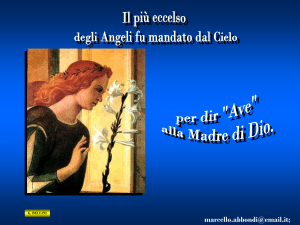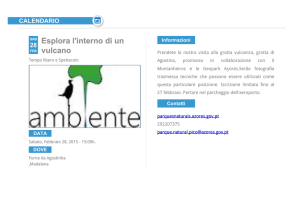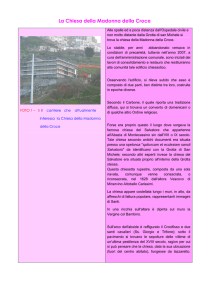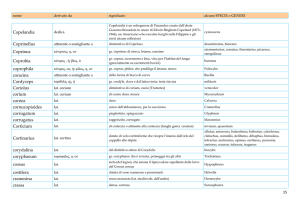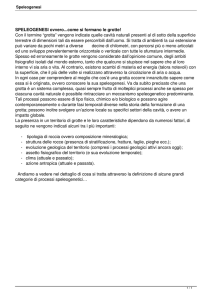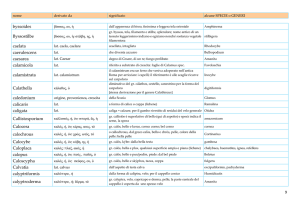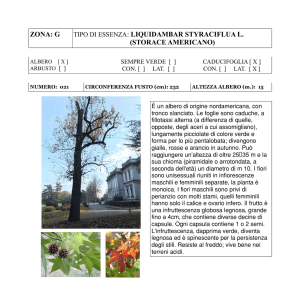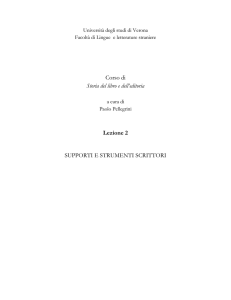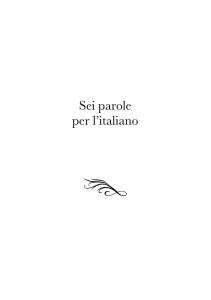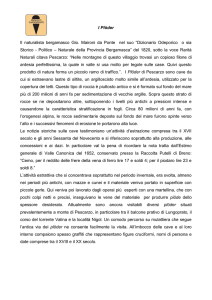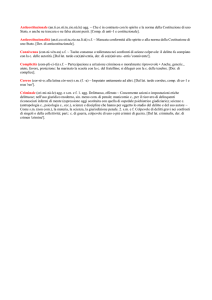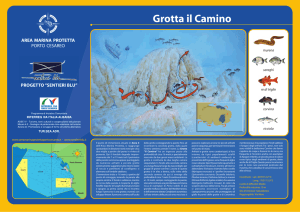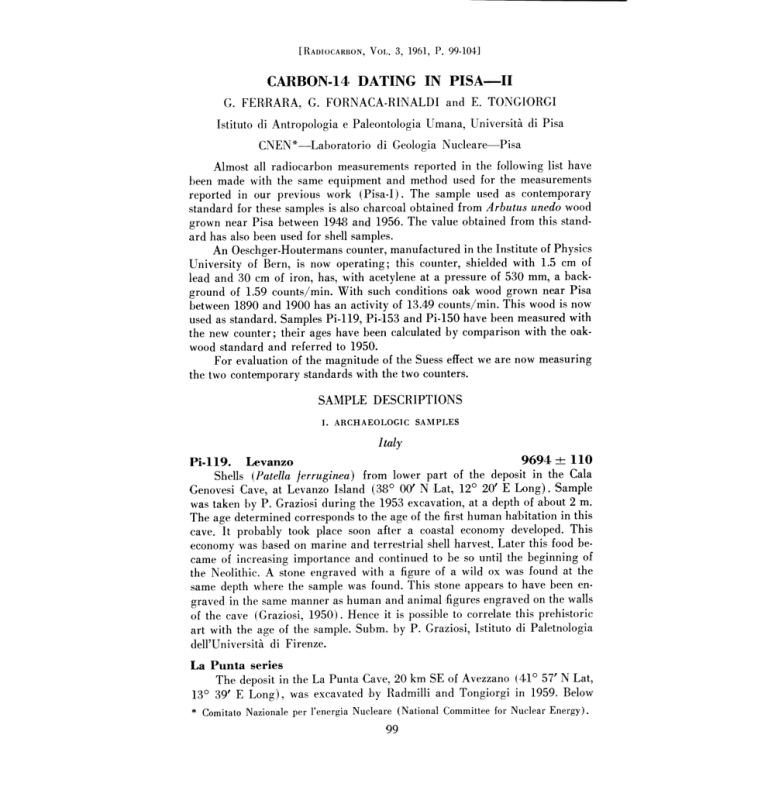
[RADIOCARBON, VOL, 3, 1961,
p. 99-1041
CARBON-14 DATING IN
PISA-II
G. FERRARA, G. FORNACA-RINALDI and E. TONGIORGI
Istituto di Antropologia e Paleontologia Umana, University di Pisa
CNEN*-Laboratorio di Geologia Nucleare-Pisa
Almost all radiocarbon measurements reported in the following list have
been made with the same equipment and method used for the measurements
reported in our previous work (Pisa-I). The sample used as contemporary
standard for these samples is also charcoal obtained from Arbutus unedo wood
grown near Pisa between 1948 and 1956. The value obtained from this standard has also been used for shell samples.
An Oeschger-Houtermans counter, manufactured in the Institute of Physics
University of Bern, is now operating; this counter, shielded with 1.5 cm of
lead and 30 cm of iron, has, with acetylene at a pressure of 530 mm, a background of 1.59 counts/min. With such conditions oak wood grown near Pisa
between 1890 and 1900 has an activity of 13.49 counts/min. This wood is now
used as standard. Samples Pi-119, Pi-153 and Pi-150 have been measured with
the new counter; their ages have been calculated by comparison with the oakwood standard and referred to 1950.
For evaluation of the magnitude of the Suess effect we are now measuring
the two contemporary standards with the two counters.
SAMPLE DESCRIPTIONS
I. ARCHAEOLOGIC SAMPLES
Italy
P1-119.
9694 ± 110
Levanzo
Shells (Patella f erruginea) from lower part of the deposit in the Gala
Genovesi Cave, at Levanzo Island (38° 00' N Lat, 12° 20' E Long). Sample
was taken by P. Graziosi during the 1953 excavation, at a depth of about 2 m.
The age determined corresponds to the age of the first human 'habitation in this
cave. It probably took place soon after a coastal economy developed. This
economy was based on marine and terrestrial shell harvest. Later this food became of increasing importance and continued to be so until the beginning of
the Neolithic. A stone engraved with a figure of a wild ox was found at the
same depth where the sample was found. This stone appears to have been engraved in the same manner as human and animal figures engraved on the walls
of the cave (Graziosi, 1950). Hence it is possible to correlate this prehistoric
art with the age of the sample. Subm. by P. Graziosi, Istituto di Paletnologia
dell'University di Firenze.
La Punta series
The deposit in the La Punta Cave, 20 km SE of Avezzano (41° 57' N Lat,
13° 39' E Long), was excavated by Radmilli and Tongiorgi in 1959. Below
* Comitato Nazionale per l'energia Nucleare (National Committee for Nuclear Energy).
99
100
G.
Ferrara, G. Fornaca-Rinaldi and E. Tongiorgi
the Neolithic layers no cultural remains were found in a section of the deposit
2 m thick. The next 2 m below contained stone implements and a large number of bones of birds and small mammals which can be supposed to have been
captured with traps.
P1-153.
Grotta La Punta
1
10,581
± 100
Charcoal from the lower part of the above described section. Underneath
this section, a deposit of 1.50 m thickness was formed during a period in which
cave was not inhabited. This period is represented in the nearby Ortucchio
Cave by sample Pi-23, 12,619 ± 410 (Pisa I).
P1-152. Grotta La Punta 2
14,488 ± 800
Charcoal from the lower part of a still deeper layer, also 1.50 m thick. A
few bones found with this sample seern to indicate an economy different from
that of the layer of Pi-153. This economy belonging to an Upper Paleolithic
culture and based on the hunting of large mammals, is well represented by remains found in many nearby caves. A 10-cm bed of volcanic ash has been
found in upper part of this layer. The ash is 'believed not to have been redeposited after the eruption and provides a good base of correlation for this
whole region.
P1-101.
6578 ± 135
Penne Di Pescara
Charcoal from the central open hearth in a house-site of a prehistoric village 3 km from Penne di Pescara (42° 28' N Lat, 13° 56' E Long). Sample
was collected by 'G. Leopardi during the 1958 excavation, one m below the
surface. Two different kinds of pottery were found in association. One of these
is the "impressed" pottery, persisting from a lower Neolithic culture; the other
is a yellowish, unpainted and untempered ware indicating the beginning of
middle Neolithic (Radmilli, 1959a). Sub'm. by G. Leopardi, Comitato per le
Ricerche Preistoriche in Abruzzo, Sopraintendenza alle Antichita di Chieti.
Grotta Piccioni series
Samples were taken from a cave (Grotta dei Piccioni) located on the
rocky side of the valley of Orte River, 500 m ENE of Bolognano (42° 13' N
Lat, 13° 58' E Long). Remains ranging from middle 'Neolithic to Iron Age
have been found in the deposit excavated (1957-1960) by A. M. Radmilli,
Istituto di Antropologia e Paleontologia Umana dell'Universita di Pisa, who
supplied the samples.
P1-46.
Grotta Piccioni
1
6247
± 130
Charcoal from an horizon where pottery belonging to an early phase of a
middle Neolithic culture was found. At the same horizon both impressed and
yellowish pottery were found. The latter was made from untempered clay and
its surface was either unpainted or decorated with a red design, without a
black outline.
P1-49. Grotta Piccioni 3
4770 ± 110
Charcoal from an upper horizon in the part of the deposit containing remains of an upper Neolithic culture. Some types of pottery are known only in
Carbon-14 Dating in Pisa-11
101
this cave; others are similar to those of the Ripoli culture; still others were
evidently influenced by the Lagozza culture dated at 4794 ± 90 (Pi-34, this
date list).
4306 ± 105
P1-50. Grotta Piccioni 4
Charcoal from a layer containing, in this thicker part, remains of an
Eneolithic culture clearly influenced by the Remedello culture.
9465
Pi-47. Grotta Piccioni 2
Earth, rich in carbonaceous matter, but without pieces of charcoal, from a
lower horizon in the same upper Neolithic layer from which sample Pi-49
(4770 ± 110, this date list) was obtained. The C1 age, clearly too old, was
inexplica'hle until bitumen pieces (Fig. 1) were found in the same layer. Ex-
Fig.
1.
Piccioni Cave-Ahruzzo-Italy
Upper Neolithic
Fig. 1. Bitumen piece found at
the same level of sample Pi-47
(nat, size).
Fig. 2. Yellowish untempered
ware repaired with bitumen
(1/2).
Fig. 2.
102
G.
Ferrara,
G.
Fornaca-Rinaldi and E. Tongiorgi
traction of bitumen from limestones in this region was practiced also during
the Roman period. Upper Neolithic inhabitants of Piccioni Cave used the bitumen to repair broken vessels, one of which (of the yellowish untempered
ware) is shown in Fig. 2.
P1-34.
Lagozza
4794 ± 90
Part of a wooden piling driven deep into the lacustrine deposit during
the lake-dwelling phase represented by the archaeologic zone 15 to 30 cm
thick at Lagozza di Besnate, 6 km NN'W of 'Busto Arsizio (45° 42' N Lat, 80°
46' E Long) . This locality, typical of the upper 'Neolithic Lagozza culture, was
excavated by 0. Cornaggia-Castiglioni in 1953 and 1954 (Cornaggia-Castiglioni, 1955), Soprintendenza alle Antichita-Milano, who submitted the samples.
P1-100.
Asciano
4248 ± 115
Charcoal found by R. Peroni during the 1955 and 1956 excavation of the
deposit under a rock ledge in the locality named "La Romita", near Asciano,
7 km NE of Pisa (43° 44' N Lat, 10° 29' E Long). Sample was collected at
the horizon containing some of the cultural remains, which in central Italy
are frequently found in burials of the Rinaldone type (related to the Remedello culture). Subm. by R. Peroni, Istituto di Antropologia e Paleontologia
Umana dell'Universita di Pisa.
P1.87.
Barche dl Solferino
3341
± 115
Wood from lake dwelling of Barche di Solferino (Zorzi, 1940) 27 km
NW of Mantova (45° 32' N Lat, 10° 34' E Long). Archaeologic findings belong to the Polada culture. Subm, by F. Zorzi, Museo Civico di Verona.
Ledro
3137 ± 105
Part of wooden piling collected by R. Battaglia during the 1937 excava-
P1-88.
tion of lake dwelling found in the Ledro lake, 7 km SE of Riva del Garda
(45° 51' 'N Lat, 10° 43' E Long) (Battaglia, 1953). 'Sample is probably contemporaneous with Polada type of pottery, but, owing to the long occupation
of the Ledro lake dwellings, this association is not entirely certain, 'Subm, by
Cleto Corrain, Istituto di Antropologia dell'Universita di Padova.
P1-81. Lavagnone
3099 ± 120
Wood from the inner part of piling underneath lake dwelling found during the extraction of peat in the Lavagnone marsh, 1 km SE of Desenzano del
Garda (43° 28' N Lat, 10° 34' E Long). The abundant prehistoric pottery
found by F. Fussi, belongs to the same culture as the Late Bronze Age finds
in Isolone del Mincio (Pi-25, 3333 ± 115; Pi-26, 3100 ± 113; Pisa I).
Subm. by F. Fussi, Museo Civico di Verona.
P1.91.
Castione Marchesi
2944 ± 105
Wood from the Terramare of Castione dei Marchesi near Fidenza, 26 km
from Parma (44° 54' N Lat, 10° 03' E Long). Subm. by Museo Nazionale di
Antichita di Parma.
P1-80.
Fucino
3366
± 130
Charcoal coll. during S.M. Puglisi's 1958 excavation in a prehistoric vii-
Carbon-14 Dating in
Pisa-II
103
lage in the Fucino plain near Ortucchio, 19 km SE of Avezzano (41° 57' N
Lat, 13° 39''E Long) . This village, on basis of shape and decoration of vessels,
is considered to belong to the sub-Appennine culture (Late Bronze Age)
(Radmilli, 1959a). The remains of this village were found 50 cm below the
surface and were superimposed upon a habitation layer with remains of an
older (Eneolithic) village (Radmilli, 1959b) . Subm. by S. M. Puglisi, Museo
Preistorico L. Pigorini di Roma.
Pi-53.
Grotta del Farneto
3240 ± 110
Charcoal from refuse deposit outside the Farneto Cave, 10 km SE of
Bologna (44° 26' N Lat, 11° 23' E Long) . Sample was coll. during the 1951
excavation (Bermond-Montanari and Radmilli, 1954 and 1955) in an horizon
very rich in pottery and implements. In spite of some archaic types, these
materials have been classified as belonging to the sub-Appennine culture (Late
Bronze Age). Subm. by A. M. Radmilli, Istituto di Antropolgia e Paleontologia
Umana dell'Universita di Pisa.
Pi-54.
Grotta Misa
3030
± 75
Charcoal found during the 1947 excavation of Cardini, Rittatore and
Tonigiorgi in the Misa Cave, 16 km N of Montalto di Castro (42° 30' N Lat,
11° 38' E Long) (Rittatore, 1949). Sample was taken from a circle of charcoal within which wheat, beans, millet and flour were burned, probably ritually
(Tongiorgi, 1947). Bronze objects and pottery found in the cave are representative of the sub-Appennine culture (Late Bronze Age). Subm. by E.
Tongiorgi.
Pi-94.
Ancona
2780 ± 95
Charcoal from lower part of archaeologic sequence found by D. Lollini
(1956) in the "Colle dei Cappuccini" within the town of Ancona (43° 37' N
Lat, 13° 31' E Long). First period of habitation, represented by this sample,
occurred during the time of the proto-Vilianovan culture. Subm.'by D. Lollini,
Soprintendenza alle Antichita di Ancona.
Pi-1.
Grotta del Fauno
2318
± 105
Charcoal found in 1955 by A. M. Radmilli during an excavation under a
rock ledge, 13 km SE of Pescasseroli (41° 44' N Lat, 13° 50' E Long). The
deposit, 2.5 m thick, consists of rubble with beds of charcoal and ashes, which
in the upper part are of the Roman period, and in the lower part contain preRoman pottery showing a local persistence of some Iron Age types. Sample
was taken from upper part of pre-Roman deposit (Radmilli, 1956). Subm. by
A. M. Radmilli, Istituto di Antropologia e Paleontologia Umana dell'Universita
di Pisa.
Pi-84.
Canoe del Trasimeno
744 ± 100
Wood from one of the dugouts found on shore of Trasimeno lake (43° 11'
N Lat, 12° 8' E Long) during drainage operations in 1958. Sample was submitted by the Soprintendenza alle Antichita di Etruria di Firenze, because in
the absence of any other kind of remains, it was impossible to confirm the
supposed prehistoric age of the dugouts.
104
G.
Ferrara,
G.
Fornaca-Rinaldi and E. Tongiorgi
II. GEOLOGIC SAMPLES
Italy
Lago di Massaciuecoli
5646 ± 220
Shell (Purpura haemastoma Consul) found in silica-sands, extracted for
industrial purposes 'between -12 and -26 m below sealevel, near Torre del
Lago (Lago di Massaciuccoli ), 15 km NNW of Pisa (45° 50' N Lat, 10° 19'
E Long). Subm, by E. Tongiorgi.
P1-116.
Pi-150.
Stagno
2991
+
115
Posidonia fibres in a near-shore sediment found near Stagno, 16 km S'SW
of Pisa (43° 36' N Lat, 10° 24' E Long) 2 m below sealevel, during the excavation of a channel. The sediment was deposited at the end of the last period
of open sea at this locality. Subm. by E. Tongiorgi.
P1-75. Campi Flegrei
10,090 ± 215
Calcareous petrified wood found during drilling of tunnel through Vomero
hill (40° 51' N Lat,.14° 21' E Long). The fossil wood was in a greenish-gray
tufa, belonging to the yellow tuf a formation at Naples. Subm, by P. Lucini,
Istituto di Geologia Applicata di Napoli.
REFERENCES
Battaglia, Raffaello, 1953, La palafitta del Lago di Ledro nel Trentino: Mem, Mus. Storia
Nat, della Venezia Tridentina, v. 7, p. 3-63.
Bermond-Montanari, Giovanna, Radmilli, Antonio, 1954 and 1955, Recenti scavi nella
Grotta del Farneto : Ital. Paletnol. Bull., v. 64, P. 137-169.
Cornaggia-Castiglioni, Ottavio, 1955, Nove ricerche sulfa stazione palafitticola della Lagozza di Besnate : Sibrium, v. 2, p. 93-104.
Ferrara, Giorgio, Reinharz, Max, and Tongiorgi, Ezio, 1959, Carbon-14 dating in Pisa I:
Am. Jour. Sci. Radioc. Supp., v, 1, p. 103-110.
Graziosi, Paolo, 1950, Le pitture ed i graffiti preistorici dell'Isola di Levanzo nell'arcipelago
dell Egadi (,Sicilia) : Riv. Sci. Preistoriche, v. 5, p. 1-44.
Lollini, Delia, 1956, L'abitato proistorico e protostorico di Ancona: Ital. Paletnol. Bull.,
n.s. 10, v. 65, p. 237-262.
Pasa, Angelo, and Durante-Pasa, Maria, 1956, Analisi pollinische e microstratigrafiche nella
torbiera di Lagozza: Mem. Mus. Civico Storia Nat. di Verona, v. 5, p. 217-228.
Pisa I, see Ferrara and others, 1959.
Radmilli, A. M., 1956, Esplorazioni paletnologiche in Abruzzo 1955: Ital. Paletnol. Bull.,
v. 65, p. 440-441.
1959a, Appunti di Preistoria Marsicana: Gli scavi nella grotta La Punta. Territorio del Fucino : Atti Soc. toscana Sci. Nat., v. 66, p. 422=432.
1959b, Insediamenti preistorici in Abruzzo : L'Universo, v. 39, p. 861-898.
Rittatore, Ferrante, 1949, Lo scavo di un deposito dell'eta del bronzo a Grotta Misa in
Etruria: Atti I° Congresso 'Preistorico Italo-Svizzero, Como, p. 8590.
Tongiorgi, Ezio, 1947, Grano, miglio e fave in un focolare dell'eta del bronzo a Grotta
Misa (Bassa valle della Fiora) : Nuov. Gior. Bot., n.s. 54, v. 1, p. 804-806.
Zorzi, Francesco, 1940, La palafitta di Barche di Solferino : Ital. Paletnol. Bull., n.s., anno
4, p. 41-82.

